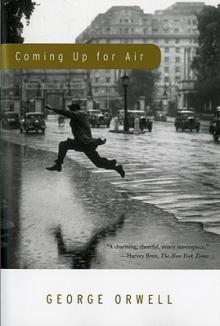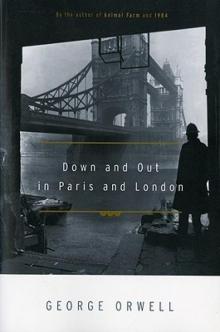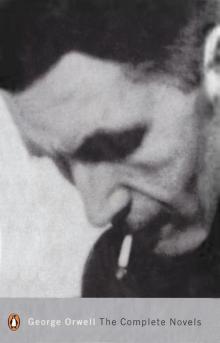- Home
- George Orwell
Fifty Orwell Essays Page 5
Fifty Orwell Essays Read online
Page 5
exhausted air is sucked out of one shaft by means of fans, and the fresh
air enters the other of its own accord. But if left to itself the air
will take the shortest way round, leaving the deeper workings
unventilated; so all the short cuts have to be partitioned off.
At the start to walk stooping is rather a joke, but it is a joke that
soon wears off. I am handicapped by being exceptionally tall, but when
the roof falls to four feet or less it is a tough job for anybody except
a dwarf or a child. You not only have to bend double, you have also got
to keep your head up all the while so as to see the beams and girders and
dodge them when they come. You have, therefore, a constant crick in the
neck, but this is nothing to the pain in your knees and thighs. After
half a mile it becomes (I am not exaggerating) an unbearable agony. You
begin to wonder whether you will ever get to the end--still more, how on
earth you are going to get back. Your pace grows slower and slower. You
come to a stretch of a couple of hundred yards where it is all
exceptionally low and you have to work yourself along in a squatting
position. Then suddenly the roof opens out to a mysterious height--scene
of and old fall of rock, probably--and for twenty whole yards you can
stand upright. The relief is overwhelming. But after this there is
another low stretch of a hundred yards and then a succession of beams
which you have to crawl under. You go down on all fours; even this is a
relief after the squatting business. But when you come to the end of the
beams and try to get up again, you find that your knees have temporarily
struck work and refuse to lift you. You call a halt, ignominiously, and
say that you would like to rest for a minute or two. Your guide (a miner)
is sympathetic. He knows that your muscles are not the same as his. 'Only
another four hundred yards,' he says encouragingly; you feel that he
might as well say another four hundred miles. But finally you do somehow
creep as far as the coal face. You have gone a mile and taken the best
part of an hour; a miner would do it in not much more than twenty
minutes. Having got there, you have to sprawl in the coal dust and get
your strength back for several minutes before you can even watch the work
in progress with any kind of intelligence.
Coming back is worse than going, not only because you are already tired
out but because the journey back to the shaft is slightly uphill. You get
through the low places at the speed of a tortoise, and you have no shame
now about calling a halt when your knees give way. Even the lamp you are
carrying becomes a nuisance and probably when you stumble you drop it;
whereupon, if it is a Davy lamp, it goes out. Ducking the beams becomes
more and more of an effort, and sometimes you forget to duck. You try
walking head down as the miners do, and then you bang your backbone. Even
the miners bang their backbones fairly often. This is the reason why in
very hot mines, where it is necessary to go about half naked, most of the
miners have what they call 'buttons down the back'--that is, a permanent
scab on each vertebra. When the track is down hill the miners sometimes
fit their clogs, which are hollow under-neath, on to the trolley rails
and slide down. In mines where the 'travelling' is very bad all the
miners carry sticks about two and a half feet long, hollowed out below
the handle. In normal places you keep your hand on top of the stick and
in the low places you slide your hand down into the hollow. These sticks
are a great help, and the wooden crash-helmets--a comparatively recent
invention--are a godsend. They look like a French or Italian steel
helmet, but they are made of some kind of pith and very light, and so
strong, that you can take a violent blow on the head without feeling it.
When finally you get back to the surface you have been perhaps three
hours underground and travelled two miles, and you, are more exhausted
than you would be by a twenty-five-mile walk above ground. For a week
afterwards your thighs are so stiff that coming downstairs is quite a
difficult feat; you have to work your way down in a peculiar sidelong
manner, without bending the knees. Your miner friends notice the
stiffness of your walk and chaff you about it. ('How'd ta like to work
down pit, eh?' etc.) Yet even a miner who has been long away front
work--from illness, for instance--when he comes back to the pit, suffers
badly for the first few days.
It may seem that I am exaggerating, though no one who has been down an
old-fashioned pit (most of the pits in England are old-fashioned) and
actually gone as far as the coal face, is likely to say so. But what I
want to emphasize is this. Here is this frightful business of crawling to
and fro, which to any normal person is a hard day's work in itself; and
it is not part of the miner's work at all, it is merely an extra, like
the City man's daily ride in the Tube. The miner does that journey to and
fro, and sandwiched in between there are seven and a half hours of savage
work. I have never travelled much more than a mile to the coal face; but
often it is three miles, in which case I and most people other than
coal-miners would never get there at all. This is the kind of point that
one is always liable to miss. When you think of the coal-mine you think
of depth, heat, darkness, blackened figures hacking at walls of coal; you
don't think, necessarily, of those miles of creeping to and fro. There is
the question of time, also. A miner's working shift of seven and a half
hours does not sound very long, but one has got to add on to it at least
an hour a day for 'travelling', more often two hours and sometimes three.
Of course, the 'travelling' is not technically work and the miner is not
paid for it; but it is as like work as makes no difference. It is easy to
say that miners don't mind all this. Certainly, it is not the same for
them as it would be for you or me. They have done it since childhood,
they have the right muscles hardened, and they can move to and fro
underground with a startling and rather horrible agility. A miner puts
his head down and runs, with a long swinging stride, through places where
I can only stagger. At the workings you see them on all fours, skipping
round the pit props almost like dogs. But it is quite a mistake to think
that they enjoy it. I have talked about this to scores of miners and they
all admit that the 'travelling' is hard work; in any case when you hear
them discussing a pit among themselves the 'travelling' is always one of
the things they discuss. It is said that a shift always returns from work
faster than it goes; nevertheless the miners all say that it is the
coming away after a hard day's work, that is especially irksome. It is
part of their work and they are equal to it, but certainly it is an
effort. It is comparable, perhaps, to climbing a smallish mountain before
and after your day's work.
When you have been down in two or three pits you begin to get some grasp
of the processes that are going on underground. (I ought to say, by the
way, that I know nothing whatever about the technical side of mining: I
am merely describing what I have seen.) Coal lies in thin seams between
enormous layers of rock, so that essentially the process of getting it
out is like scooping the central layer from a Neapolitan ice. In the old
days the miners used to cut straight into the coal with pick and
crowbar--a very slow job because coal, when lying in its virgin state,
is almost as hard as rock. Nowadays the preliminary work is done by an
electrically-driven coal-cutter, which in principle is an immensely
tough and powerful band-saw, running horizontally instead of vertically,
with teeth a couple of inches long and half an inch or an inch thick. It
can move backwards or forwards on its own power, and the men operating
it can rotate it this way or that. Incidentally it makes one of the most
awful noises I have ever heard, and sends forth clouds of coal dust
which make it impossible to see more than two to three feet and almost
impossible to breathe. The machine travels along the coal face cutting
into the base of the coal and undermining it to the depth of five feet
or five feet and a half; after this it is comparatively easy to extract
the coal to the depth to which it has been undermined. Where it is
'difficult getting', however, it has also to be loosened with
explosives. A man with an electric drill, like a rather small version of
the drills used in street-mending, bores holes at intervals in the coal,
inserts blasting powder, plugs it with clay, goes round the corner if
there is one handy (he is supposed to retire to twenty-five yards
distance) and touches off the charge with an electric current. This is
not intended to bring the coal out, only to loosen it. Occasionally, of
course, the charge is too powerful, and then it not only brings the coal
out but brings the roof down as well.
After the blasting has been done the 'fillers' can tumble the coal out,
break it up and shovel it on to the conveyor belt. It comes out first in
monstrous boulders which may weigh anything up to twenty tons. The
conveyor belt shoots it on to tubs, and the tubs are shoved into the main
road and hitched on to an endlessly revolving steel cable which drags
them to the cage. Then they are hoisted, and at the surface the coal is
sorted by being run over screens, and if necessary is washed as well. As
far as possible the 'dirt'--the shale, that is--is used for making the
roads below. All what cannot be used is sent to the surface and dumped;
hence the monstrous 'dirt-heaps', like hideous grey mountains, which are
the characteristic scenery of the coal areas. When the coal has been
extracted to the depth to which the machine has cut, the coal face has
advanced by five feet. Fresh props are put in to hold up the newly
exposed roof, and during the next shift the conveyor belt is taken to
pieces, moved five feet forward and re-assembled. As far as possible the
three operations of cutting, blasting and extraction are done in three
separate shifts, the cutting in the afternoon, the blasting at night
(there is a law, not always kept, that forbids its being done when other
men are working near by), and the 'filling' in the morning shift, which
lasts from six in the morning until half past one.
Even when you watch the process of coal-extraction you probably only
watch it for a short time, and it is not until you begin making a few
calculations that you realize what a stupendous task the 'fillers' are
performing. Normally each o man has to clear a space four or five yards
wide. The cutter has undermined the coal to the depth of five feet, so
that if the seam of coal is three or four feet high, each man has to cut
out, break up and load on to the belt something between seven and twelve
cubic yards of coal. This is to say, taking a cubic yard as weighing
twenty-seven hundred-weight, that each man is shifting coal at a speed
approaching two tons an hour. I have just enough experience of pick and
shovel work to be able to grasp what this means. When I am digging
trenches in my garden, if I shift two tons of earth during the afternoon,
I feel that I have earned my tea. But earth is tractable stuff compared
with coal, and I don't have to work kneeling down, a thousand feet
underground, in suffocating heat and swallowing coal dust with every
breath I take; nor do I have to walk a mile bent double before I begin.
The miner's job would be as much beyond my power as it would be to
perform on a flying trapeze or to win the Grand National. I am not a
manual labourer and please God I never shall be one, but there are some
kinds of manual work that I could do if I had to. At a pitch I could be a
tolerable road-sweeper or an inefficient gardener or even a tenth-rate
farm hand. But by no conceivable amount of effort or training could I
become a coal-miner, the work would kill me in a few weeks.
Watching coal-miners at work, you realize momentarily what different
universes people inhabit. Down there where coal is dug is a sort of world
apart which one can quite easily go through life without ever hearing
about. Probably majority of people would even prefer not to hear about
it. Yet it is the absolutely necessary counterpart of our world above.
Practically everything we do, from eating an ice to crossing the
Atlantic, and from baking a loaf to writing a novel, involves the use of
coal, directly or indirectly. For all the arts of peace coal is needed;
if war breaks out it is needed all the more. In time of revolution the
miner must go on working or the revolution must stop, for revolution as
much as reaction needs coal. Whatever may be happening on the surface,
the hacking and shovelling have got to continue without a pause, or at
any rate without pausing for more than a few weeks at the most. In order
that Hitler may march the goose-step, that the Pope may denounce
Bolshevism, that the cricket crowds may assemble at Lords, that the poets
may scratch one another's backs, coal has got to be forthcoming. But on
the whole we are not aware of it; we all know that we 'must have coal',
but we seldom or never remember what coal-getting involves. Here am I
sitting writing in front of my comfortable coal fire. It is April but I
still need a fire. Once a fortnight the coal cart drives up to the door
and men in leather jerkins carry the coal indoors in stout sacks smelling
of tar and shoot it clanking into the coal-hole under the stairs. It is
only very rarely, when I make a definite mental-effort, that I connect
this coal with that far-off labour in the mines. It is just
'coal'--something that I have got to have; black stuff that arrives
mysteriously from nowhere in particular, like manna except that you have
to pay for it. You could quite easily drive a car right across the north
of England and never once remember that hundreds of feet below the road
you are on the miners are hacking at the coal. Yet in a sense it is the
miners who are driving your car forward. Their lamp-lit world down there
is as necessary to the daylight world above as the root is to the
> flower.
It is not long since conditions in the mines were worse than they are
now. There are still living a few very old women who in their youth have
worked underground, with the harness round their waists, and a chain that
passed between their legs, crawling on all fours and dragging tubs of
coal. They used to go on doing this even when they were pregnant. And
even now, if coal could not be produced without pregnant women dragging
it to and fro, I fancy we should let them do it rather than deprive
ourselves of coal. But-most of the time, of course, we should prefer to
forget that they were doing it. It is so with all types of manual work;
it keeps us alive, and we are oblivious of its existence. More than
anyone else, perhaps, the miner can stand as the type of the manual
worker, not only because his work is so exaggeratedly awful, but also
because it is so vitally necessary and yet so remote from our experience,
so invisible, as it were, that we are capable of forgetting it as we
forget the blood in our veins. In a way it is even humiliating to watch
coal-miners working. It raises in you a momentary doubt about your own
status as an 'intellectual' and a superior person generally. For it is
brought home to you, at least while you are watching, that it is only
because miners sweat their guts out that superior persons can remain
superior. You and I and the editor of the Times Lit. Supp., and the poets
and the Archbishop of Canterbury and Comrade X, author of Marxism for
Infants--all of us really owe the comparative decency of our lives to
poor drudges underground, blackened to the eyes, with their throats full
of coal dust, driving their shovels forward with arms and belly muscles
of steel.
NORTH AND SOUTH (FROM "THE ROAD TO WIGAN PIER") (1937)
As you travel northward your eye, accustomed to the South or East, does
not notice much difference until you are beyond Birmingham. In Coventry
you might as well be in Finsbury Park, and the Bull Ring in Birmingham is
not unlike Norwich Market, and between all the towns of the Midlands there
stretches a villa-civilization indistinguishable from that of the South.
It is only when you get a little further north, to the pottery towns and
beyond, that you begin to encounter the real ugliness of
industrialism--an ugliness so frightful and so arresting that you are
obliged, as it were, to come to terms with it.
A slag-heap is at best a hideous thing, because it is so planless and
functionless. It is something just dumped on the earth, like the emptying
of a giant's dust-bin. On the outskirts of the mining towns there are
frightful landscapes where your horizon is ringed completely round by
jagged grey mountains, and underfoot is mud and ashes and over-head the
steel cables where tubs of dirt travel slowly across miles of country.
Often the slag-heaps are on fire, and at night you can see the red
rivulets of fire winding this way and that, and also the slow-moving blue
flames of sulphur, which always seem on the point of expiring and always
spring out again. Even when a slag-heap sinks, as it does ultimately, only
an evil brown grass grows on it, and it retains its hummocky surface. One
in the slums of Wigan, used as a playground, looks like a choppy sea
suddenly frozen; 'the flock mattress', it is called locally. Even
centuries hence when the plough drives over the places where coal was once
mined, the sites of ancient slag-heaps will still be distinguishable from
an aeroplane.
I remember a winter afternoon in the dreadful environs of Wigan. All
round was the lunar landscape of slag-heaps, and to the north, through the
passes, as it were, between the mountains of slag, you could see the
factory chimneys sending out their plumes of smoke. The canal path was a
mixture of cinders and frozen mud, criss-crossed by the imprints of
innumerable clogs, and all round, as far as the slag-heaps in the

 Animal Farm & 1984
Animal Farm & 1984 Homage to Catalonia
Homage to Catalonia Decline of the English Murder
Decline of the English Murder Coming Up for Air
Coming Up for Air Keep the Aspidistra Flying
Keep the Aspidistra Flying Facing Unpleasant Facts: Narrative Essays
Facing Unpleasant Facts: Narrative Essays The Complete Novels of George Orwell
The Complete Novels of George Orwell All Art Is Propaganda: Critical Essays
All Art Is Propaganda: Critical Essays Down and Out in Paris and London
Down and Out in Paris and London Why I Write
Why I Write Nineteen Eighty-Four
Nineteen Eighty-Four A Life in Letters
A Life in Letters Essays
Essays A Clergyman's Daughter
A Clergyman's Daughter Fifty Orwell Essays
Fifty Orwell Essays Burmese Days
Burmese Days Shooting an Elephant
Shooting an Elephant 1984 (Penguin)
1984 (Penguin) A Collection of Essays
A Collection of Essays 1984
1984 The Complete Novels
The Complete Novels All Art Is Propaganda
All Art Is Propaganda Orwell in Spain
Orwell in Spain Animal Farm: A Fairy Story
Animal Farm: A Fairy Story Animal Farm and 1984
Animal Farm and 1984